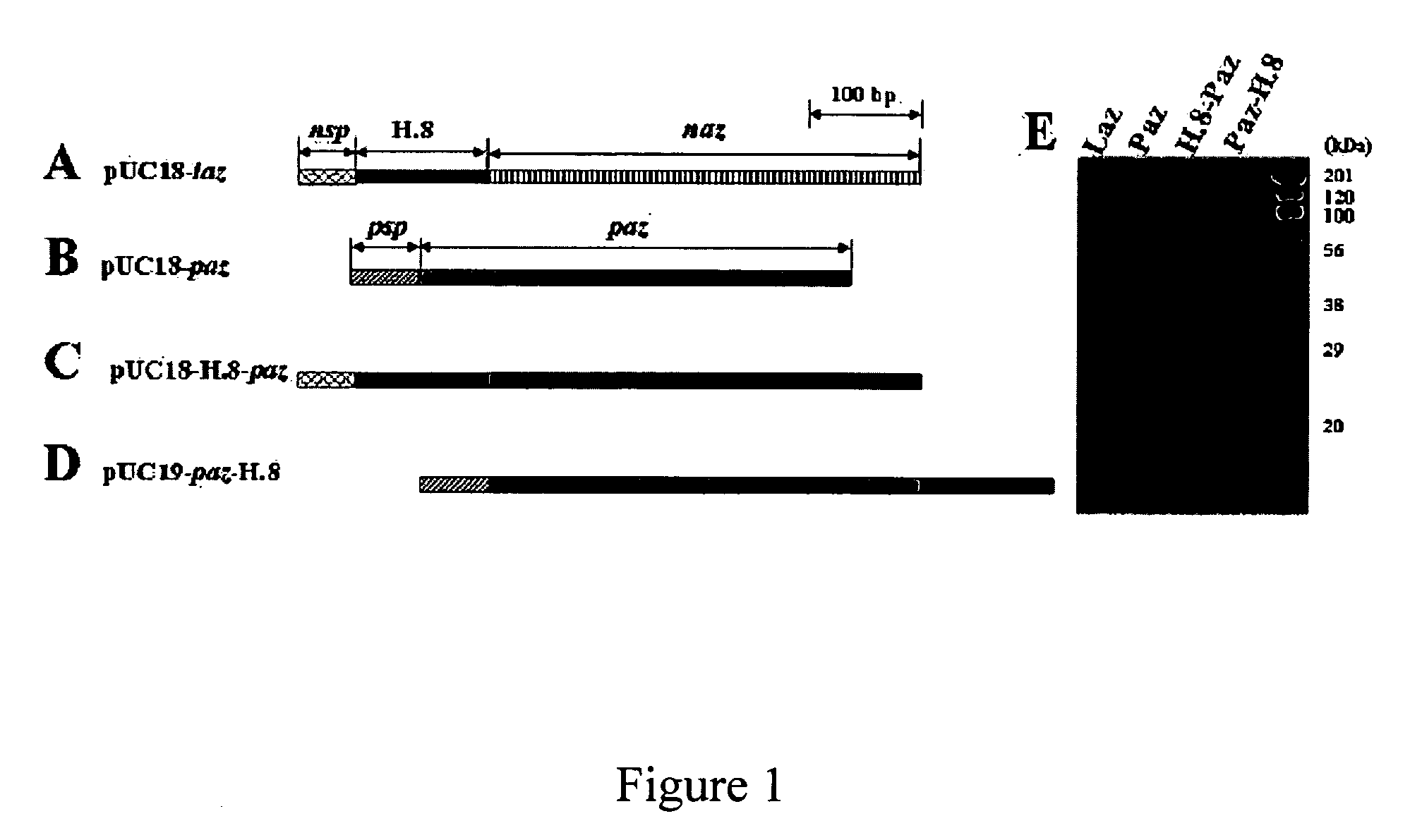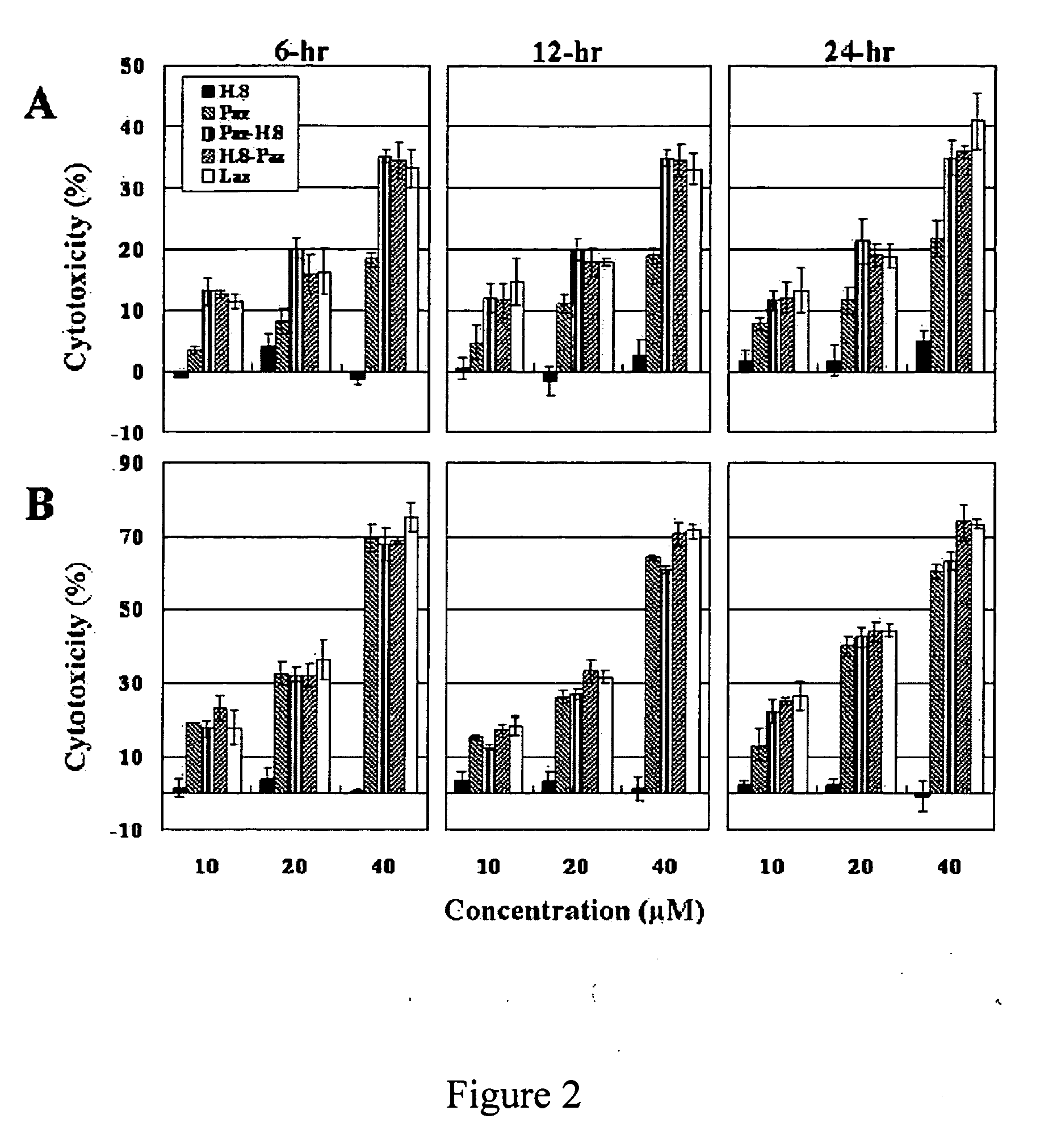Transport agents for crossing the blood-brain barrier and into brain cancer cells, and methods of use thereof
a technology of transport agent and brain cancer, which is applied in the direction of peptide/protein ingredients, dna/rna fragmentation, echographic/ultrasound-imaging preparations, etc., can solve the problems of slow progress, difficult to treat brain cancer, and inability to administer transvascular routes to the vast majority of drug candidates, so as to facilitate the entry of a linked molecule
- Summary
- Abstract
- Description
- Claims
- Application Information
AI Technical Summary
Benefits of technology
Problems solved by technology
Method used
Image
Examples
example 1
Cloning And Expression of the Laz and H.8-Azurin Fusion Genes
[0164]The laz gene from Neisseria gonorrhoeae was cloned (FIG. 1A) based on its known sequence (SEQ ID NO: 1). The P. aeruginosa azurin gene (SEQ ID NO: 2), termed paz (FIG. 1B), and the sequence of the H.8 epitope of laz from N. gonnerrhoeae (SEQ ID NO: 3), were used to clone in frame the H.8 epitope gene in the 5′-end of paz to produce H.8-paz (FIG. 1C) or in the 3′-end of paz to generate paz-H.8 (FIG. 1D), as described below.
[0165]Cell Lines and Reagents. Human cancer cells, bacterial strains and plasmids are listed in Table 5. The human breast cancer MCF-7 cells and brain tumor LN-229 cells are from the stock culture collection of the Department of Surgical Oncology, University of Illinois at Chicago (UIC). The cells were cultured in MEM with Eagle's salt containing 2 mM L-glutamine, 0.1 mM MEM essential amino acids and supplemented with 10% heat-inactivated fetal bovine serum, 100 units / ml penicillin and 100 μg / ml str...
example 2
H.8 Enhances the Cytotoxicity of P. aeruginosa Azurin Towards Glioblastoma Cells But Not Breast Cancer Cells
[0175]The preferential entry of Paz towards cancer cells (Yamada, et al., Cell. Microbiol. 7:1418-1431 (2005)) and its cytotoxicity, both in vitro and in vivo towards human melanoma (Yamada, et al., Proc. Natl. Acad. Sci. USA 99:14098-14103 (2002)) and breast cancer (Punj, et al., Oncogene 23:2367-2378 (2004)), have been reported. However, no effect of Paz or Laz towards brain tumors such as glioblastomas is known. Here the effect of Paz, Laz, H.8-Paz (H.8 epitope in the N— terminal of Paz) and Paz-H.8 (H.8 epitope in the C-terminal of Paz) on both glioblastoma (LN-229 cell line) and breast cancer (MCF-7 cell line) cells was studied.
[0176]Preparations of Proteins. Azurin (Paz) of P. aeruginosa, Laz of N. gonorrhoeae, Paz-H.8 and H.8-Paz were purified as described previously. (Yamada, et al., Proc. Natl. Acad. Sci. USA 99:14098-14103 (2002); Punj, et al., Oncogene 23:2367-2378 ...
example 3
H.8 Epitope Present in Paz or Laz Facilitates the Uptake of Azurin in Glioblastoma Cells
[0179]The enhanced cytotoxicity of Paz-H.8, H.8-Paz and Laz towards glioblastoma cells as compared to Paz, raised the question if the H.8 moiety somehow facilitated the uptake of azurin in glioblastoma cells. Alexa fluor® 568-labeled red fluorescent proteins (Invitrogen-Molecular Probes Corp., Carlsbad Calif.) were used to determine the internalization of these proteins inside glioblastoma and breast cancer cells. This technique was previously used to demonstrate the internalization of azurin in MCF-7 cells (Punj, et al., Oncogene 23:2367-2378 (2004); Yamada, et al., Cell. Microbiol. 7:1418-1431 (2005)).
[0180]Confocal Microscopy. For preparation of microscopic samples, cells were cultured on coverslips overnight at 37° C. under 5% CO2. Pre-warmed 37° C. fresh media were mixed with red fluorescent-labeled (Alexa fluor® 568) azurin or GST fusion derivatives, and incubated with the cells for indicat...
PUM
| Property | Measurement | Unit |
|---|---|---|
| molecular mass | aaaaa | aaaaa |
| half life | aaaaa | aaaaa |
| total length | aaaaa | aaaaa |
Abstract
Description
Claims
Application Information
 Login to View More
Login to View More - R&D
- Intellectual Property
- Life Sciences
- Materials
- Tech Scout
- Unparalleled Data Quality
- Higher Quality Content
- 60% Fewer Hallucinations
Browse by: Latest US Patents, China's latest patents, Technical Efficacy Thesaurus, Application Domain, Technology Topic, Popular Technical Reports.
© 2025 PatSnap. All rights reserved.Legal|Privacy policy|Modern Slavery Act Transparency Statement|Sitemap|About US| Contact US: help@patsnap.com



